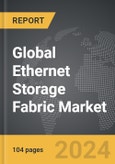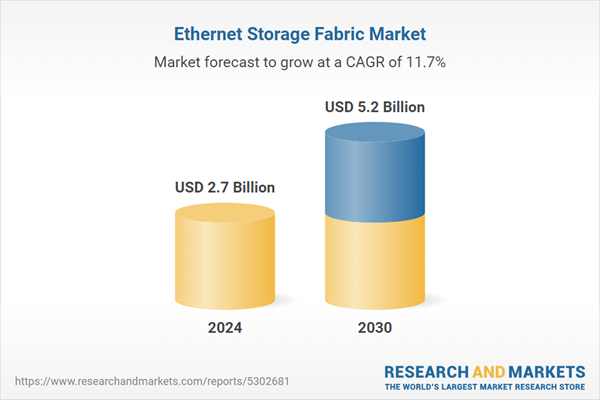Global Ethernet Storage Fabric (ESF) Market - Key Trends & Drivers Summarized
Why Is Ethernet Storage Fabric Essential for Modern Data Centers and Enterprise Storage?
Ethernet Storage Fabric (ESF) is a high-performance storage network that connects data storage systems with compute and application environments via Ethernet. Designed to support data-intensive applications and multi-cloud environments, ESF offers fast, low-latency access to storage resources, ensuring scalability, flexibility, and improved data management. Unlike traditional storage networking protocols like Fibre Channel, ESF leverages Ethernet, making it more cost-effective, easier to manage, and ideal for modern workloads, including big data analytics, artificial intelligence, and virtualized environments. ESF allows enterprises to handle large volumes of data with the high-speed access necessary for real-time analytics, decision-making, and seamless access across data centers.With its ability to deliver high throughput and low latency, ESF is integral to enterprise storage infrastructure, enabling quick data access for mission-critical applications. As organizations increasingly transition to cloud-native environments, ESF provides a highly efficient, flexible, and resilient solution for managing complex data needs. Its scalability supports both large enterprises and hyperscale data centers, making it essential for organizations seeking to manage growing data volumes and improve overall infrastructure efficiency.
How Are Technological Advancements Shaping the Ethernet Storage Fabric Market?
Technological advancements in Ethernet Storage Fabric, including improvements in Ethernet speed, software-defined networking (SDN), and NVMe-over-Fabrics (NVMe-oF), are enhancing performance and expanding ESF applications. The adoption of 25G, 50G, and 100G Ethernet connections enables faster data transfer speeds, reducing latency and meeting the demands of high-performance applications. These speeds support data-intensive tasks and storage environments where traditional Ethernet speeds would be inadequate, facilitating efficient real-time data processing in complex environments.Software-defined networking (SDN) allows for more precise control over ESF configurations, enabling automated network management, optimized traffic flows, and dynamic resource allocation. This SDN integration improves scalability, making it easier to adapt ESF to changing workload requirements. Additionally, the rise of NVMe-over-Fabrics (NVMe-oF) has brought significant improvements to ESF, allowing high-speed NVMe SSDs to be shared across Ethernet networks without sacrificing performance. These advancements enable ESF to handle high-volume, low-latency storage workloads, supporting applications like AI, machine learning, and high-performance computing (HPC). Together, these technologies make ESF more powerful and flexible, allowing organizations to scale their storage networks efficiently.
What Are the Key Applications of Ethernet Storage Fabric?
Ethernet Storage Fabric is applied across industries and environments requiring high-speed, scalable, and flexible storage solutions. In data centers, ESF supports storage area networking (SAN) with high throughput, which is essential for managing complex, large-scale storage resources. Data centers use ESF to support private and hybrid cloud storage, ensuring that data is easily accessible and securely managed across cloud environments. ESF is also widely used in enterprise IT environments to improve virtualized storage performance and reduce latency in shared storage systems, supporting applications such as databases, transaction processing, and virtual desktop infrastructure (VDI).In media and entertainment, ESF facilitates high-speed storage access for large video files, editing software, and rendering applications, providing the low latency and high bandwidth necessary for smooth workflows. The financial services industry also benefits from ESF, using it to manage high-frequency trading platforms, data analysis, and large data transfers with minimal delays. Additionally, in healthcare, ESF enables fast access to large datasets, such as medical imaging and electronic health records (EHRs), ensuring efficient data management and real-time analytics. These applications highlight the versatility of ESF in supporting industries that rely on robust, fast, and scalable storage networks.
What Is Driving Growth in the Ethernet Storage Fabric Market?
The growth in the Ethernet Storage Fabric market is driven by the expansion of data-intensive applications, the need for scalable storage solutions, advancements in Ethernet technology, and the transition to cloud and hybrid environments. The increasing adoption of data analytics, artificial intelligence, and machine learning across industries has led to greater demand for high-performance, low-latency storage networks that support real-time data access and analysis. ESF's scalability and performance capabilities make it ideal for these data-heavy workloads, driving market demand as organizations seek to optimize data processing and storage efficiency.Advancements in Ethernet speeds and NVMe-oF technology are supporting market growth by allowing ESF to handle modern workloads more effectively, especially in hyperscale and enterprise data centers. These advancements make ESF a cost-effective alternative to traditional storage networks, particularly for companies looking to manage their storage resources flexibly and efficiently. The shift to cloud and hybrid IT environments is also propelling demand for ESF, as companies seek versatile storage networks that integrate easily with their multi-cloud infrastructure.
The growth in edge computing, where low-latency data access is critical, further supports the market as ESF provides the needed performance for processing data close to the source. Together, these factors - data-intensive applications, advancements in Ethernet, cloud adoption, and edge computing - are driving robust growth in the ESF market, positioning it as a foundational technology for next-generation storage solutions.
Report Scope
The report analyzes the Ethernet Storage Fabric market, presented in terms of market value (US$ Thousand). The analysis covers the key segments and geographic regions outlined below.- Segments: Device (Switches, Adapters, Controllers); Storage Type (Hyper-Converged Infrastructure, Block Storage, File Storage, Object Storage); Application (Enterprise Data Center, Cloud Service Provider Data Center, Telecommunications, Government).
- Geographic Regions/Countries:World; United States; Canada; Japan; China; Europe (France; Germany; Italy; United Kingdom; Spain; Russia; and Rest of Europe); Asia-Pacific (Australia; India; South Korea; and Rest of Asia-Pacific); Latin America (Argentina; Brazil; Mexico; and Rest of Latin America); Middle East (Iran; Israel; Saudi Arabia; United Arab Emirates; and Rest of Middle East); and Africa.
Key Insights:
- Market Growth: Understand the significant growth trajectory of the Switches segment, which is expected to reach US$2.6 Billion by 2030 with a CAGR of a 12.8%. The Adapters segment is also set to grow at 11.4% CAGR over the analysis period.
- Regional Analysis: Gain insights into the U.S. market, valued at $679.2 Million in 2024, and China, forecasted to grow at an impressive 15.5% CAGR to reach $1.2 Billion by 2030. Discover growth trends in other key regions, including Japan, Canada, Germany, and the Asia-Pacific.
Why You Should Buy This Report:
- Detailed Market Analysis: Access a thorough analysis of the Global Ethernet Storage Fabric Market, covering all major geographic regions and market segments.
- Competitive Insights: Get an overview of the competitive landscape, including the market presence of major players across different geographies.
- Future Trends and Drivers: Understand the key trends and drivers shaping the future of the Global Ethernet Storage Fabric Market.
- Actionable Insights: Benefit from actionable insights that can help you identify new revenue opportunities and make strategic business decisions.
Key Questions Answered:
- How is the Global Ethernet Storage Fabric Market expected to evolve by 2030?
- What are the main drivers and restraints affecting the market?
- Which market segments will grow the most over the forecast period?
- How will market shares for different regions and segments change by 2030?
- Who are the leading players in the market, and what are their prospects?
Report Features:
- Comprehensive Market Data: Independent analysis of annual sales and market forecasts in US$ Million from 2024 to 2030.
- In-Depth Regional Analysis: Detailed insights into key markets, including the U.S., China, Japan, Canada, Europe, Asia-Pacific, Latin America, Middle East, and Africa.
- Company Profiles: Coverage of players such as Allied Telesis Holdings K.K., Apeiron Data Systems, Argo Technologie SA, Arista Networks, Cisco Systems, Inc. and more.
- Complimentary Updates: Receive free report updates for one year to keep you informed of the latest market developments.
Some of the 63 companies featured in this Ethernet Storage Fabric market report include:
- Allied Telesis Holdings K.K.
- Apeiron Data Systems
- Argo Technologie SA
- Arista Networks
- Cisco Systems, Inc.
- Dell Technologies Inc.
- D-Link
- E8 Storage
- Edgecore Networks
- Fortinet, Inc.
- Fujitsu
- H3C Technologies Co., Limited
- Hewlett Packard Enterprise Company
- Huawei Technologies Co., Ltd.
- Intel Corporation
- Juniper Networks
- Lenovo Group Ltd.
- Mellanox Technologies, Ltd
- Microsemi Corporation
- Vcinity
This edition integrates the latest global trade and economic shifts into comprehensive market analysis. Key updates include:
- Tariff and Trade Impact: Insights into global tariff negotiations across 180+ countries, with analysis of supply chain turbulence, sourcing disruptions, and geographic realignment. Special focus on 2025 as a pivotal year for trade tensions, including updated perspectives on the Trump-era tariffs.
- Adjusted Forecasts and Analytics: Revised global and regional market forecasts through 2030, incorporating tariff effects, economic uncertainty, and structural changes in globalization. Includes historical analysis from 2015 to 2023.
- Strategic Market Dynamics: Evaluation of revised market prospects, regional outlooks, and key economic indicators such as population and urbanization trends.
- Innovation & Technology Trends: Latest developments in product and process innovation, emerging technologies, and key industry drivers shaping the competitive landscape.
- Competitive Intelligence: Updated global market share estimates for 2025, competitive positioning of major players (Strong/Active/Niche/Trivial), and refined focus on leading global brands and core players.
- Expert Insight & Commentary: Strategic analysis from economists, trade experts, and domain specialists to contextualize market shifts and identify emerging opportunities.
Table of Contents
Companies Mentioned (Partial List)
A selection of companies mentioned in this report includes, but is not limited to:
- Allied Telesis Holdings K.K.
- Apeiron Data Systems
- Argo Technologie SA
- Arista Networks
- Cisco Systems, Inc.
- Dell Technologies Inc.
- D-Link
- E8 Storage
- Edgecore Networks
- Fortinet, Inc.
- Fujitsu
- H3C Technologies Co., Limited
- Hewlett Packard Enterprise Company
- Huawei Technologies Co., Ltd.
- Intel Corporation
- Juniper Networks
- Lenovo Group Ltd.
- Mellanox Technologies, Ltd
- Microsemi Corporation
- Vcinity
Table Information
| Report Attribute | Details |
|---|---|
| No. of Pages | 402 |
| Published | December 2025 |
| Forecast Period | 2024 - 2030 |
| Estimated Market Value ( USD | $ 2.7 Billion |
| Forecasted Market Value ( USD | $ 5.2 Billion |
| Compound Annual Growth Rate | 11.7% |
| Regions Covered | Global |









